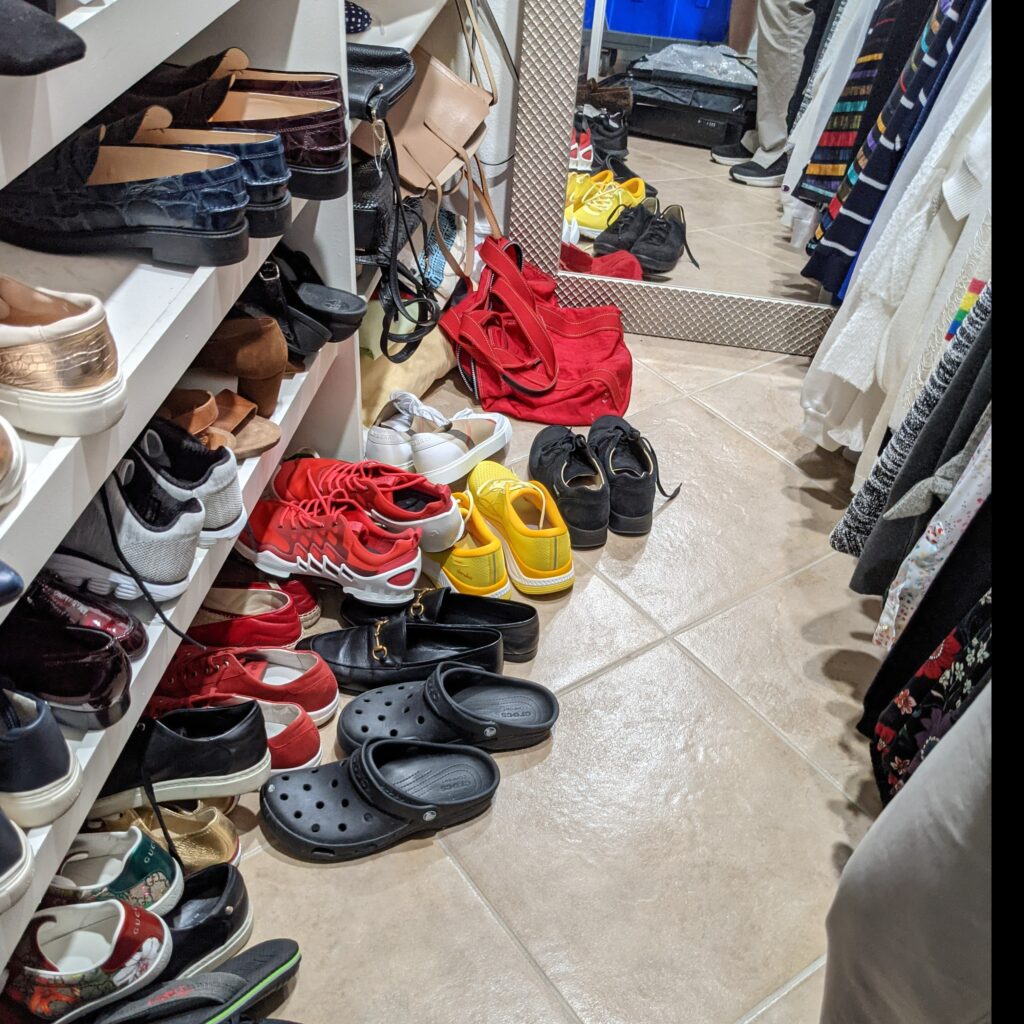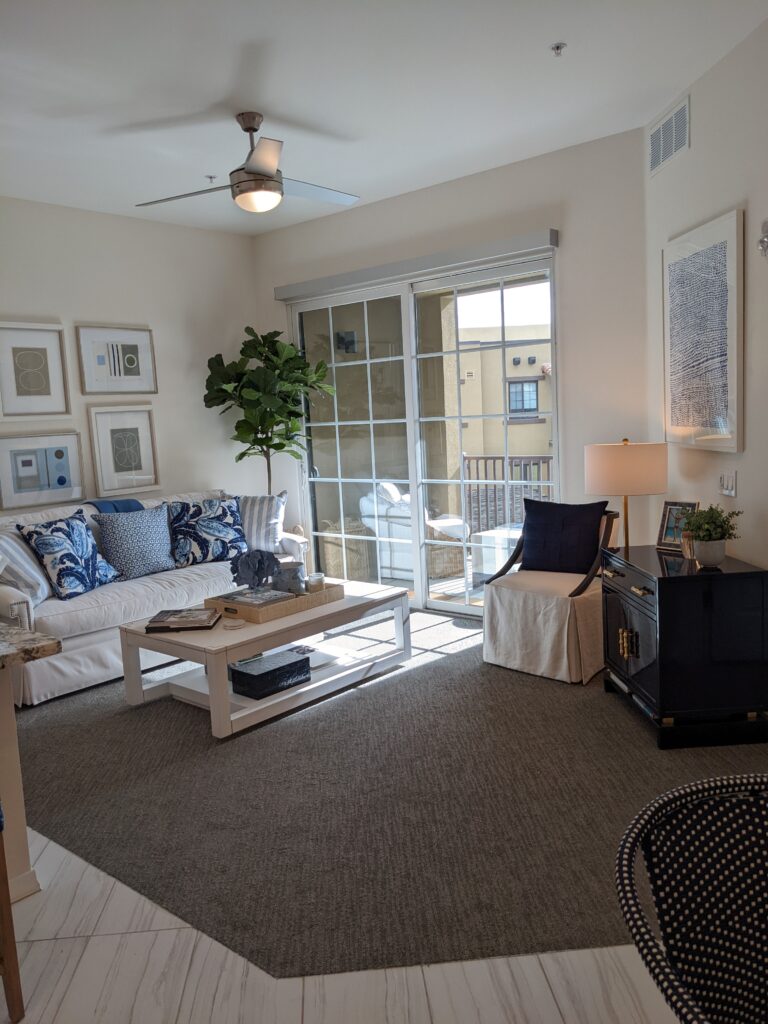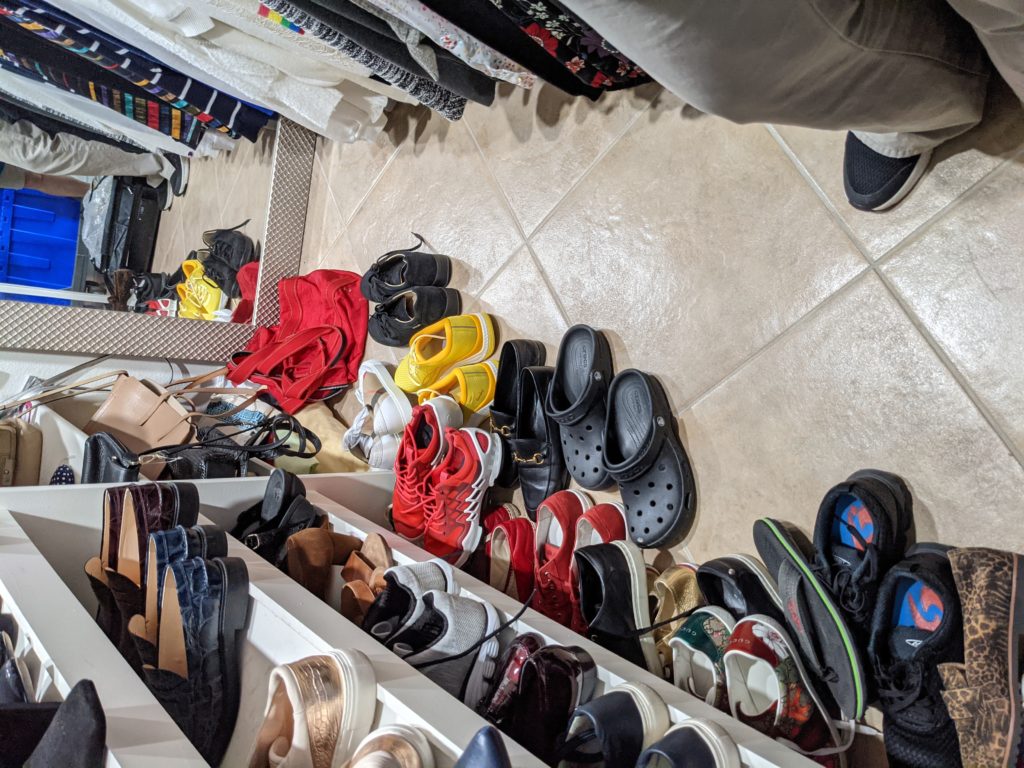
Estate Clearing with Dignity, Respect, and Compassion
Losing a loved one is an emotional and challenging time, and handling their estate can feel overwhelming. At Arizona Senior Moving, we understand that estate clearing is much more than just removing belongings—it’s about honoring the wishes of the deceased and their family while handling every item with care and respect. Unlike junk haulers who indiscriminately remove everything, we provide a compassionate and personalized approach, ensuring that every step is handled with dignity.
More Than Just Hauling Away
Estate clearing is not just about emptying a home—it’s about preserving memories, uncovering important documents or sentimental items, and making sure everything is placed where it needs to go.
Our team at Arizona Senior Moving specializes in:
• Sorting Through Belongings: We help families go through personal belongings, identifying items of value, sentimental significance, and those best suited for donation or disposal.
• Locating Hidden or Lost Items: Over the years, we have helped families find misplaced jewelry, important legal documents, and treasured keepsakes that might have otherwise been lost in the process.
• Facilitating Donations: Many families choose to donate household goods and clothing. We coordinate the transportation of these items to local charities to ensure they go to those in need.
• Dispersing Items to Family: Whether it’s distributing cherished belongings to local relatives or arranging for items to be shipped across the country, we take care of the logistics so families don’t have to worry.
“At Arizona Senior Moving Company, we specialize in being equipped to provide all the necessary steps of emptying out a home in a caring, efficient and responsible manner.”
Compassionate and Personalized Estate Clearing
We understand that every estate is unique, and so are the needs of the family handling it. That’s why we tailor our estate clearing services to your specific situation. Some families want to be involved in every step, while others prefer to entrust the process entirely to our team. Whatever your needs, we are here to help.
Unlike companies that simply haul everything away without consideration, we take the time to:
• Respectfully handle sentimental and valuable items
• Provide family members with the opportunity to review belongings before they are removed
• Ensure that items go to the right place, whether that’s a donation center, recycling, or family members
Why Choose Arizona Senior Moving for Estate Clearing?
Arizona Senior Moving sets itself apart from traditional estate clearing services by focusing on care, organization, and respect. We are not just another moving company—we are specialists in senior moving and estate clearing with years of experience assisting families during some of their most difficult transitions. Our team:
• Approaches every move with compassion and professionalism
• Offers full-service support, from sorting and packing to delivery and donation coordination
• Ensures that the wishes of the deceased and their family are honored
• Provides peace of mind in knowing that the estate clearing process is being handled with care
A Stress-Free Estate Clearing Experience
We recognize that estate clearing can be physically and emotionally exhausting. Our goal is to relieve as much stress as possible by managing the details for you. Whether you need help clearing out a home after the passing of a loved one or preparing a property for sale, we offer a service that is both efficient and respectful.
If you or someone you know needs estate clearing services handled with dignity, respect, and compassion, Arizona Senior Moving is here to help. Contact us today for a free consultation and let us guide you through this process with care and expertise.
Call us today: 602-620-9941

Your Guide to Moving to La Siena: Expert Tips from Arizona Senior Moving
Discover a Smoother Move to La Siena with Arizona Senior Moving
Are you planning a move to La Siena? Whether you’re an incoming resident or moving from one apartment to another within the community, Arizona Senior Moving is here to ensure that your move is as smooth and stress-free as possible. La Siena recommends us as a preferred mover, and it’s easy to see why—our approach to senior moving in Phoenix goes far beyond just getting you from point A to point B.
Your Trusted Partner in Senior Moving
At Arizona Senior Moving, we specialize in moving seniors with care, understanding that moving later in life comes with unique challenges. Our commitment is to make every move as comfortable as possible, by anticipating the details that matter most. Unlike other moving companies in the Phoenix area, our services are designed with a focus on personalized planning, leveraging years of experience to ensure nothing is overlooked.
Why La Siena Recommends Choosing Arizona Senior Moving
La Siena residents have discovered that partnering with Arizona Senior Moving brings numerous benefits:
• Specialized Expertise: We have a wealth of experience moving residents into La Siena. This means we understand the community’s layout, common challenges, and the best strategies for efficient moves.
• Personalized Services: Every move is unique. Our team listens to your specific needs and works with you to ensure a comfortable transition.
• Clickable Floorplan Tips: One of the standout features that sets us apart is our interactive floorplans available on our moving to La Siena page. These floorplans are more than just a layout—they’re a practical tool packed with insider tips tailored specifically for senior moves. When you click on any room or area of your prospective apartment, you receive detailed information on important considerations for what will fit and tips for comfortable living in your new space. This tool is the result of years of specialized experience, making it easier than ever to visualize and plan your move.
Tailored Tips in Every Floorplan
Every interactive floorplan comes loaded with practical tips based on our extensive experience moving seniors into La Siena. These aren’t generic suggestions; they’re personalized insights derived from years of handling moves in this very community. Whether it’s recommending a love seat over a full-sized couch for a particular living room layout or advising on alternative organizing solutions for the kitchen, our floorplans provide actionable advice that you won’t find anywhere else. Here’s how they can help you plan your move:
Thoughtful Insights & Practical Tips
Room Layout: It’s not just about the size of the rooms—it’s about the functionality of every space. Our recommendations include practical details, such as how many pieces of furniture to consider bringing and whether a full-sized couch or a love seat is the better fit for your living room, based on the layout.
Outlet and Light Switch Placement: We also pinpoint the locations of outlets and light switches. This might seem like a small detail, but it can make a huge difference in planning your electronics setup and lighting. Knowing these placements in advance means you can arrange your study, living room, or kitchen without the hassle of additional extension cords or awkward rearrangements.
Kitchen and Laundry Considerations: Our floorplans highlight the kitchen cabinet and drawer spaces, so you can plan for any extra storage needs or alternative organization solutions. Our floorplans identify these potential challenges, so you can prepare in advance. For instance, if you see that your kitchen has fewer drawers than expected, you can plan to bring extra organizational containers to keep your utensils, spices, and other kitchen essentials neatly arranged. Similarly, knowing about a stacked washer and dryer lets you plan where to store your laundry essentials, ensuring your daily routine isn’t disrupted.
Real-Life Considerations: Beyond the basics, we also note unexpected features like the presence or absence of a linen closet, and whether bedroom closets are spacious enough for all your clothes. These insights help you avoid surprises and ensure a smoother transition.
Why Choose Arizona Senior Moving?
When it comes to senior moving in Phoenix, Arizona Senior Moving stands apart from the rest. Other companies might focus solely on the physical aspect of moving, maybe have hired a couple of empolyees to help with packing or unpacking a senior move, or offer a concierge service, but we understand that a successful move involves careful planning and attention to detail. Our expertise means we’ve seen firsthand the common challenges seniors face and have developed tools—like our interactive floorplans—to help you navigate those challenges with ease.
From providing a detailed overview of apartment floorplans to advising on the best organizational strategies, our goal is to make your transition into La Siena as seamless as possible. We take pride in offering a service that’s not just about moving items, but about moving your life with the care and attention you deserve.
Ready to Plan Your Move?
If you’re considering a move to La Siena, we invite you to visit our moving to La Siena page here and explore our interactive floorplans. Discover the difference that detailed, practical planning can make. With Arizona Senior Moving, you’re not only choosing a company that cares about the logistics of your move, but one that cares about your comfort, organization, and peace of mind throughout the entire process.
Let us help you plan a move that’s thoughtful, well-organized, and perfectly tailored to your needs. Trust in our expertise and experience a moving process that’s designed specifically with you in mind—because at Arizona Senior Moving, moving seniors is all we do!
________________________________________
Make your move to La Siena a step into a new chapter with confidence, clarity, and care—choose Arizona Senior Moving, where every detail is taken care of. Call today for a Free Estimate! 602-620-9941
Click here to go to our Moving to La Siena Floorplans Page

Making Your Move Easy: Why Arizona Senior Moving Company Is the Right Choice for You
Starting Fresh with Confidence
Moving into a senior community is an exciting milestone, but let’s be honest—it can also be a little overwhelming. Whether you’re thinking about packing everything yourself or you’d rather have someone take care of it for you, the right moving company can make all the difference. At Arizona Senior Moving Company, we specialize in helping seniors transition smoothly and stress-free. Our services are designed with your unique needs in mind, making your move easier and more enjoyable.
Understanding the Challenges of Senior Moves
Moving later in life comes with its own set of challenges. Downsizing, organizing, and adjusting to a new environment can feel like a lot to handle. You might be wondering how to sort through years of belongings or feeling uncertain about how the move will unfold. That’s where we step in—our team understands the emotional and logistical aspects of senior moving and provides support tailored to your situation.
Why Arizona Senior Moving Company Stands Out
We’re not just a moving company; we’re specialists in senior moves—because that’s all we do. Our dedicated team ensures a personalized experience that takes your concerns into account. Here’s why seniors trust us:
- Comprehensive Services Tailored for Seniors: Need help with your move including downsizing and organizing? We provide full-service solutions that make moving easier. Moving Seniors is all we do, so we understand the importance of handling your belongings with care and attention to detail.
- A Stress-Free Experience: We take the worry out of moving by handling everything from logistics to safely packing your cherished items. You can focus on your other responsibilites such as paperwork and Dr. visits while we take care of the heavy lifting.
- Thoughtful Packing Services: Packing can be one of the most daunting parts of a move. Our professional, all women team ensures your items are securely packed, labeled, and ready for easy unpacking. Once you arrive, we’ll have everything set up just the way you like it—beds made, pictures hung, and items neatly placed where they belong.
- Trusted Senior-Friendly Movers: Our all-women packing and unpacking team is known for their patience, kindness, and understanding of seniors’ unique needs. We don’t just move boxes; we help create a smooth transition into your new lifestyle.
- Affordable Moving Options: We believe quality moving services should be reasonable, which is why we offer competitive pricing and free estimates. You get excellent service without breaking the bank.
Let us take care of every detail so you can focus on other important tasks—like doctor visits and paperwork—while we handle the packing and moving.
What Our Clients Say
Still unsure? Here’s what some of our happy customers have to say:
“Arizona Senior Moving Company made my move into an assisted living community so easy. They took care of everything, and I felt supported every step of the way!” – Mary S.
“I was dreading downsizing, but their team was amazing. They helped me sort through my belongings and made the process stress-free.” – John D.
Moving into a senior community should be an exciting new chapter, not a stressful one. With Arizona Senior Moving Company, you’ll have a dedicated team that truly understands your needs and is here to support you every step of the way.
📞 Ready to make your move stress-free? Call us today for a free quote! 602-620-9941

Senior Downsizing Myths Debunked – The Truth About Simplifying Your Life for Seniors
Senior downsizing can feel like an intimidating task, especially for seniors transitioning to a smaller space or a senior living community. Misconceptions about what it means to downsize often lead to unnecessary stress and hesitation. But the truth is, senior downsizing isn’t about loss—it’s about gaining a simpler, more manageable lifestyle. In this post, we’ll debunk common senior downsizing myths and show you how to embrace the process with confidence.
Myth #1: Senior Downsizing Means Losing Everything You Love
One of the biggest fears about senior downsizing is parting with sentimental items. However, downsizing isn’t about giving up everything you love; it’s about focusing on the things that truly matter.
The Reality: Senior downsizing allows you to prioritize cherished belongings. Whether it’s a family photo album or a favorite piece of furniture, the goal is to create a home filled with meaningful items.
Pro Tip: Use creative solutions like shadow boxes or digital photo frames to preserve and display memories in smaller senior-friendly spaces.
Myth #2: Senior Downsizing is Only for Financial Reasons
Many seniors believe downsizing is solely about saving money, but the benefits extend far beyond finances.
Reality: Senior downsizing can improve quality of life by reducing home maintenance, increasing safety, and offering opportunities to live closer to loved ones or in a more supportive senior community.
Pro Tip: Look at senior downsizing as an investment in peace of mind and a simpler lifestyle, rather than just a financial decision.
Myth #3: Senior Downsizing is Too Overwhelming to Handle
It’s natural to feel overwhelmed when facing years of accumulated belongings, but you don’t have to do it alone.
The Reality: Breaking the senior downsizing process into manageable steps and seeking professional help can make it smooth and stress-free.
Pro Tip: Senior moving specialists, like Arizona Senior Moving Company, can guide you through each step, from sorting items to settling into your new senior-friendly home.
Myth #4: Family Will Take Care of Everything
While family support is valuable, relying solely on loved ones can be challenging for both parties.
The Reality: Families often have busy schedules and may not have the expertise to handle a senior move efficiently.
Pro Tip: Hiring senior moving professionals ensures that the process is handled with care and attention, relieving both you and your family of unnecessary stress.
Myth #5: Moving to a Smaller Senior Home Means Sacrificing Comfort
Senior downsizing doesn’t mean you’ll lose the comfort of your current home—it just means reimagining it on a smaller scale.
The Reality: A thoughtfully planned senior-friendly space can be just as cozy and functional as a larger one. With the right furniture and organization, small spaces can feel open and inviting.
Pro Tip: Consider multipurpose furniture, like ottomans with storage or foldable tables, to maximize space while maintaining comfort.
Senior downsizing isn’t about sacrifice—it’s about making intentional choices that lead to a more manageable and fulfilling lifestyle. By letting go of misconceptions and seeking the right support, you can transform senior downsizing into an exciting new chapter. If you’re ready to embrace the benefits of senior downsizing, Arizona Senior Moving Company is here to help. Contact us today for compassionate, expert assistance that takes the stress out of moving.

Need Help Breaking Up With Your Sole Mates?
Let us help you make it through breaking up with your sole mates quickly and easily. Let’s pair this task down…
1. Take a quick pass thru your shoe collection and pull any shoes that are torn, worn and in bad condition.
Put them in a trash bag.
2. Next, get a box for donation and take a second pass through your shoe collection and pull any types of shoes that you can no longer comfortably wear or that are unstable or unsafe for you to wear.
Put them in your donation box. They may be:
- Heels
- Wedges
- Flip Flops
- Lace-ups
- Stiff-soled shoes
- Sling backs
3. Next, consider this: It’s not realistic to think that you will only keep the shoes that you will wear every day. Why? Because you may need a pair of each of the following to put in your Keepers pile:
- Dress shoes
- Tennis shoes or comfortable walking shoes
- Slippers or slip-ons that you wear around the house
4. Next, honestly look at your shoe collection and pull any shoes that you have not worn in a year. You may have loved them at the store, but found out after wearing them that they are completely uncomfortable. Resist the urge to hang on to them.
Put them in your donation box. Maybe someone else’s feet will enjoy them!
5. Take one last look at the shoes you have left. Any shoes with a layer of dust on them and in good condition are candidates for the donate box.
Be honest with yourself: You don’t want to keep shoes that you never wear even if you like them. They will just keep reminding you that you are not wearing them or that you can’t wear them!
6. Immediately take the bags of shoes that are going to the trash out and put them in the trash.
7. Immediately take the boxes of shoes that are to be donated and put them in your car so that the next time you’re out, you can drop them off.
8. Arrange the shoes you are keeping in your closet so that they are easy to see what you have and easy to reach them to put them on.
Ok, so now, you have successfully made it through breaking up with the real heels in your life and you can enjoy time with your true sole mates!
If you are downsizing or getting ready to move to a Senior Community – whether it’s a House, Independent or Assisted Living Community, give us a call at 602-620-9941 for a free consultation to discuss how Arizona Senior Moving can help you through this most important senior move.

Self-Care Tips for Senior Moving
Moving can be a daunting task for anyone, but for seniors, it can be particularly challenging. The physical and emotional stress of packing up a lifetime of memories and relocating to a new home can take a toll. However, with the right self-care tips, seniors can navigate the moving process more smoothly and ensure their well-being throughout. In this article, we will explore essential self-care tips for senior moving that can make the transition easier and more comfortable.
Moving is a significant life event that requires careful planning and consideration, especially for seniors. It’s essential to prioritize self-care during this time to minimize stress and promote overall well-being. From physical preparation to emotional support, there are several key aspects to consider when it comes to senior moving. Let’s dive into some effective self-care tips that seniors can incorporate into their moving process.
Self Care Tips for Senior Moving
Moving involves various tasks, decisions, and emotions. It’s crucial for seniors to take care of themselves throughout this period to ensure a smooth transition. Here are some practical self-care tips for senior moving:
1. Start Early and Plan Ahead
Moving requires careful planning, especially for seniors. Start the preparation process well in advance to avoid last-minute stress. Create a detailed moving checklist, outlining tasks such as sorting belongings, packing, notifying relevant parties, and arranging transportation. Having a plan in place will help alleviate anxiety and ensure a more organized move.
2. Enlist Help from Family and Friends
Don’t hesitate to reach out to loved ones for support. Moving can be physically demanding, and having a helping hand can make a world of difference. Whether it’s packing, lifting heavy items, or emotional support, family and friends can provide valuable assistance throughout the moving process.
3. Declutter and Downsize
Moving presents an excellent opportunity to declutter and downsize belongings. Seniors can go through their possessions and determine what to keep, donate, or discard. Downsizing can make the moving process more manageable and also help create a fresh and organized living space in the new home.
4. Seek Professional Moving Services
Consider hiring professional movers who specialize in assisting seniors like Arizona Senior Moving. We have experience handling delicate items and can provide extra care during the packing and transportation process. Professional movers like Arizona Senior Moving can also alleviate physical strain and ensure the safety of belongings.
5. Stay Organized with Labeling
Labeling boxes and containers is essential for efficient unpacking. Clearly mark each box with its contents and the room it belongs to. This labeling system will save time and effort when settling into the new home. Additionally, it will prevent confusion and frustration during the unpacking process. Ask us about our unique and efficient system of packing your belongings so they arrive safely and so that we can put them away for you quickly.
6. Take Breaks and Rest
Moving can be physically exhausting, so it’s crucial for seniors to take regular breaks and rest as needed. Overexertion can lead to fatigue and increased risk of injury. Pace yourself throughout the moving process and listen to your body’s needs.
At Arizona Senior Moving Company, we only move seniors. We are passionate about helping you have a peaceful move.

Small Ways to Personalize Your Senior Living Apartment
Moving into a Senior Living Apartment can be an exciting but strange time in your life. You’re not alone if you feel like your apartment isn’t quite yours yet. Adding your personality to the home can help you acclimate and warm up to your new life. And doing so doesn’t have to cost you a lot of money or time. Instead, use the suggestions below to spruce up your new home with minimal effort and money.
Add fresh plants
Head to a local garden store or grocery store and choose a bouquet of your favorite flowers or a new potted plant with lush greenery. Natural pops of color can make any room feel more inviting, and a bouquet placed on the kitchen island or counter or the table can cheer up your space. Plants can draw attention to central areas or fill in empty spaces. Plus, flowers make for a great conversation starter with guests.
Accent a wall
While you may not be used to the layout of your new home yet, an accent wall can help you solidify the flow of an area and add layers of your personality. There are a few avenues to choose from when it comes to accent walls: you can have maintenance paint them, strategically place a favorite piece of furniture as a focal point for the wall, or hang a large picture or picture grouping to create an accent wall.
Clean with your favorite products
Everyone’s home has a distinct smell. Typically, your home will take on the scent of the cleaning products you use. Most people don’t recognize their home’s scent, but if the smell of your new home feels strange and unfamiliar, dust your furniture with your favorite furniture polish, quickly wipe the counters with your favorite cleaner or dish soap and rag and spray your favorite air freshener or place fragrance plugins in a few outlets and you’ll notice how much more familiar and cozy every room feels.
Customize your storage
Finding a place for your belongings is a big step you can take to make your new place feel like home. From hooks by the front door to self-closing drawers and under-bed storage, think through each room in your home and how you can make it more functional.
Hang a photo wall
Display or hang your favorite photos of your family, friends, and pets on a wall where you can enjoy them. Keep them in the frames or pick new frames that match your color scheme.
Decorate the front door and add some decorations
Impress your guests by hanging a wreath on your door. Some communities allow for decorations such as plaques or figurines next to your front door. Display things to spruce up your front door and express who you are. It will help you find your apartment and introduce you to your neighborsIf y.
Spruce up an outdoor space
If you have a patio, it’s important to create a space for chatting and relaxing. Invest in comfortable chairs that will still give you plenty of space to easily maneuver your patio. A small side table or two is all that you need on your porch if your space is limited. Senior Communities often have large outdoor patios that are centrally located with comfortable seating so that you can enjoy the outdoors. Don’t take your large patio furniture for your small patio or porch, enjoy the benefits your Senior Community provides with their larger outdoor seating areas. This can encourage you to spend time getting fresh air and decompressing from your big move. Plus, it’s a great way to chat with neighbors passing by and have a safe social distancing location to enjoy a few drinks and snacks with them.
By making these changes, you can turn your new Senior Assisted Living Apartment into a home quickly and easily. Arizona Senior Moving can help you with all these ideas on your move-in day!

Top 7 Reasons Seniors Downsize
Like many things in life, there are no courses or manuals for making some of its most important decisions. Whether they’re emotional or financially driven, or a combination of both, sometimes you just have to go with your gut. And while there’s no easy answer, recognizing your motivations for downsizing can help you make the final decision on whether it’s time to stay or go.
Financial stability: Are you retired or experiencing financial hardships? Have your monthly expenses increased over the years due to the escalation in the cost of living? If so, this may be an opportune time to downsize, especially If you’re feeling a financial crunch. Selling your home for a smaller, lesser expensive place can help you to save money, reduce your monthly expenses, and possibly increase your disposable income.
Home equity: If you’ve owned your home for several years, there’s likely a lot of equity, particularly with the rise in home prices over the past few years. This may be a great reason to sell as you can use the proceeds from the sale to downsize and have some cash left over to add to your nest egg.
Homeownership: Are you tired of being a homeowner and no longer want the responsibilities of the upkeep or ongoing expense? Whether it’s due to financial, physical, or other circumstances, it may be a good time to discuss selling and explore rental options or consider a Senior Living Community.
Home upkeep: Having less maintenance is often the key reason for downsizing. Not only can it be costly, but it can also be dangerous. For example, if you’re older and have to climb on your roof to clean the gutters, you may be putting yourself at risk of a serious fall. If you’re beginning to feel overwhelmed with your home’s upkeep, it may be a good time to consider a downsizing move.
Life changes: Unexpected major life-changing events, such as divorce or the death of a spouse or partner or an illnes or injury, may require you to make some changes, both in your financial life and your lifestyle. They may even be the catalyst for making your final decision to downsize.
Lifestyle: Have you aged out of your neighborhood? Are you an empty nester and your home now feels lonely or too big for you? If so, it may be time to consider downsizing to a smaller home and into a community that makes sense for you. There are many options in the Phoenix and Sun City area for Active Adult Communities and Senior Communities that match your financial and lifestyle needs with other like-minded people.
Proximity to family: Your adult children and grandchildren may not live close to you anymore and chances are you want to be in closer proximity to them. Whether you’re retired or still in the workforce and able to work remotely, it may be the right time to sell and downsize.
If you’ve decided to begin the downsizing process, be thorough in your research—the options are endless. Whether your motivations have to do with a lifestyle change, lower cost of living, or health challenges, be sure to contact Arizona Senior Moving to assist you in your downsizing adventure “Home upkeep: Having less maintenance is often the key reason for downsizing.” “Life changes: Unexpected major life-changing events, such as divorce or the death of a spouse or partner, may require you to make some changes, both in your financial life and your lifestyle.” .
,
How To Be In The Top 15% of Women With Your Shoe Collection
“According to a recent study by ShopSmart magazine, the average American woman owns 19 pairs of shoes, with 15% of women owning 30 or more pairs. How did I compare? Surely, not being a shoe person, I should be safe. So I counted the shoes in my closet. After about a dozen boots, 10 pairs of flats, and an assortment of wedges, pumps and sandals, I was fast approaching a total of 30 – and the prospect of officially being a “shoe girl.” Dreading this harsh reality, I simply skipped over several pairs of shoes that I intend to throw out at some point soon (just not today; I might need them!). Then I realized maybe I was – gulp – one of them. I had too many shoes” (Blake, 2008).
Sound familiar?
You open your closet, the prospect of moving to your new apartment in a senior community you’ve chosen motivating you to start packing and sorting through your belongings, only to be intimidated by the very first thing you see: Your shoe collection.
Shelf after shelf, stack after stack, shoes piled everywhere. Heels, flats, sneakers, and boots.
You lose count around fifty pairs, overwhelmed by the sheer amount of footwear you accumulated over the years.
Congratulations! You’re in the top 15% of women with a shoe collection!
So, intimidated by the prospect of having to sort through your shoes alone and struggling to choose the best pairs to take? Call Arizona Senior Moving Company! Our team of ladies will help you not only sort through your shoes, but also pack and organize the rest of your house so that you have as peaceful of a move as possible.


Operation Declutter
What words would you use to describe your home? If you said peaceful, clean, inviting, or organized, congratulations—it sounds like you’ve cracked the declutter code. If you said chaotic, overwhelming, or messy, let’s chat. Of course, it’s perfectly natural for your home to alternate through phases of clean and cluttered; we’re human, after all. Here are some strategies for streamlining your space.
ENTRYWAY: Establish a landing area for your keys, wallet, purse, and shoes. A console table with a small bowl can hold keys, or a tiny hook in the wall will suffice if the space is small. If you don’t have a coat closet, install coat hooks along one wall and slide a shoe rack underneath it.
KITCHEN: Let the decanting begin! Choose some jars of various sizes to hold grains, nuts, seeds, pasta, and flour. To store smaller amounts, you can save money by soaking off the labels of pasta sauce or pickle jars. This will not only make your pantry look more cohesive but also make it much easier to know what you need at the grocery store to replenish your supplies.
LIVING ROOM: One word: curate. Pretend you are staging your living room as if it were an Airbnb. How do you want guests to feel in the space? What could you get rid of to make the room more livable and inviting? If you’re holding onto knickknacks solely out of guilt, give yourself permission to toss them.
BEDROOM: Are you overwhelmed by the amount of clothing in your closet? Consider a capsule wardrobe of thirty coordinated pieces that will make getting ready for the day much simpler. Try designating a “maybe” bin if you have trouble being decisive. If you don’t miss the items of clothing in the bin after a few days, you know it’s time to donate them.
BATHROOM: Change your habitat instead of your habits. If your dirty clothes always find their way onto the bathroom floor, move your laundry hamper into the bathroom. Do you have half-full bottles of shampoo that you used and didn’t like or face masks gifted to you by well-meaning friends? To paraphrase Elsa from Frozen, “Let them go!”
Think of decluttering as a journey and not a destination. It’s a constant process of assessing your habits and establishing systems, like taking out the trash every Tuesday or hanging up three shirts before going to bed. Instagram is a great resource if you are someone who likes to follow a plan. Search #declutterchallenge for weeklong, monthlong, or even yearlong strategies. Or commit to a “no-buy month” (other than essentials) and get to the root of your motivation to accumulate. Go forth and declutter!
